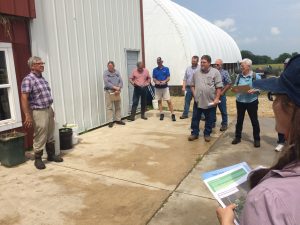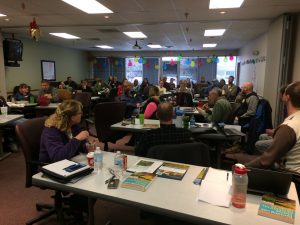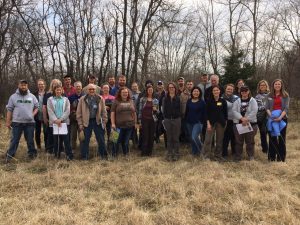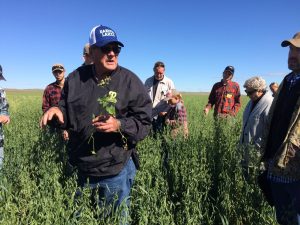Final report for ENC13-140
Project Information
Native insects that attack crop pests are an overlooked resource in agricultural systems. Although vast numbers of such beneficial insects are at work on farms across the world, they are eclipsed in farm education by a comparatively smaller diversity of pest species. Yet, as a large body of research now demonstrates, farmers as diverse as Christmas tree growers in Illinois to blueberry growers in Michigan benefit from natural pest control.
To address this need, we developed the Conservation Biological Control Short Course, which synthesizes the latest research on beneficial insect conservation and offers realistic solutions for enhancing beneficial insect populations on farms. This project was the outgrowth of a six-year research initiative conducted by the Xerces Society and university research partners, and in the short course, we presented conservation biological control as an easy-to-adopt framework for multiple crop systems. Specific course topics include beneficial insect biology, designing habitat enhancements, farm practices to support beneficial insects, pesticide risk mitigation, securing financial support through USDA programs, and real-world case studies.
We promoted our project through multiple channels, as well as in partnership with relevant agencies and State SARE Coordinators. During the project, we collaborated with IPM specialists, university researchers, extension personnel, NRCS conservation planners, Soil and Water Conservation District technicians, staff from state departments of agriculture, crop consultants, farmer organizations, and sustainable agriculture organizations to offer the courses in each state in the North Central SARE region. We partnered with local farmers, research stations, and agricultural organizations to get course participants out on farms whenever possible to demonstrate the concepts we taught. Qualitative and quantitative post-course feedback received from participants was incorporated on an ongoing basis.
Through this project, 374 people from all North Central SARE states attended one of twelve Conservation Biological Control Short Courses, with an average attendance of over 30 participants per course. Follow-up surveys showed that short courses improved attendees’ skills and capacity to implement beneficial insect habitat and adopt farm management practices such as incorporating flowering cover crops, reducing tillage, and changing pesticide use to protect beneficial insects. This project also helped increase participation in and familiarity with USDA conservation programs. Agricultural service providers who attended a short course reported enrolling a total of 25 farms in NRCS conservation programs for beneficial insects.
During this three-year project, we delivered 12 Conservation Biological Control Short Courses in all North Central SARE states, providing training for 374 participants, exceeding our goal of 350 short course attendees. Participants, including farmer educators, conservation agency staff, crop consultants, farm professionals, and other stakeholders, received in-depth training in the latest science-based strategies of ecological pest control. Individual workshop goals included:
- At least 30 participants per course
- Conservation practices adopted on at least 1,000 acres per course
- New enrollments in USDA conservation programs resulting from each course
Wild predator and parasitoid insects play a central role in terrestrial ecosystems and in the past were the primary means of pest control on farms. With the advent of chemical insecticides, however, the contribution of beneficial insects has largely been overlooked. Insecticides alone have not solved the problem of crop pests. Despite ongoing insecticide use, both the absolute value and the overall proportion of crop losses due to pests in the U.S. have increased.
It is widely recognized that pest control provided by beneficial insects remains significant. In one of the first economic studies of its kind, scientists at Cornell University found that the value of native beneficial insects for crop pest control in the U.S. is estimated to be at least $4.5 billion annually. Specifically in the North Central SARE region, an estimate by Doug Landis from Michigan State University and his colleagues found that suppression of soybean aphid alone by beneficial insects was worth $239 million a year (based on 2008 soybean prices) in just four states: Iowa, Michigan, Minnesota, and Wisconsin.
While native beneficial insects contribute enormously to agriculture, insecticide use and loss of habitat has led to declining beneficial insect numbers on farms. To investigate the possibility of reversing this trend and achieving economically meaningful levels of pest control, the Xerces Society partnered with UC Berkeley on a six-year study of beneficial insect habitat management practices. Investigators examined changes in pest and beneficial insect populations on farms where specific conservation practices were adopted versus farms that did not provide habitat and found that the restoration of native habitat supported significantly more beneficial insects and harbored fewer pests than weedy, highly disturbed field edges.
To ensure that these findings were not specific to California, we spent several years compiling additional findings from across the country and comparing notes with key biological control researchers in the North Central SARE region, including Dr. Rufus Isaacs (Michigan State University), Dr. Mary Gardiner (Ohio State University), Dr. Matt O’Neal (Iowa State University), and others.
The concept of providing habitat for native insects that attack pests is referred to as conservation biological control. Conservation biological control increases numbers of wild beneficial insects by providing the habitat they need to thrive. Because farms are often subject to farm practices like pesticide use, tillage, and mowing of field borders that affect habitat for beneficial insects, they don’t have enough alternative food sources and shelter to support large numbers of beneficial insects. For example, many insect predators and parasitoids feed on wildflower pollen and nectar when prey are scarce or simply as an alternative food source.
To address this need for habitat, researchers working across regions and crop systems have independently identified simple engineered habitats and management practices that consistently enhance natural pest control. These strategies include the establishment of native plant field borders, flowering hedgerows, in-field insectary strips, and beetle banks; cover cropping; conservation tillage; and pesticide risk mitigation.
Conservation biological control offers multiple, high value benefits that align with other sustainable agriculture priorities, such as reducing the need for insecticides, contributing to soil and water protection, and supporting other wildlife, such as pollinators and songbirds. Although these benefits are widely recognized, conservation biological control has historically been limited by a lack of practical information on implementation. This project removes that barrier by providing training to agricultural service providers in all North Central states.
Cooperators
Education
This Short Course was modeled upon a previous, highly successful SARE PDP project conducted by the Xerces Society for North Central SARE (the “Pollinator Conservation Short Course”). Based upon numerous participant requests from that earlier project, we developed this complementary program to train agricultural professionals on how to conserve predator and parasitoid insects.
This full-day training is made up of the following modules:
- Introduction to ecological pest control
- Beneficial insect biology and identification
- Farm practices and pesticide risk mitigation
- Assessing baseline farm conditions for beneficial insects
- Designing and restoring habitat
- Accessing technical and financial resources through USDA conservation programs
Our teaching format consists of a multimedia lecture and is supported by a participant toolkit that includes farm and habitat management guidelines, insect identification guides, and relevant Extension, NRCS, and Xerces Society publications. Some of those publications include the national NRCS handbook, Beneficial Insect Habitat Planning, a guide to pesticide risk mitigation, and the book Farming with Beneficial Insects.
Course publications and lecture modules were developed in consultation with scientific advisors at land grant universities across the U.S. and are based upon the latest peer-reviewed research. The curriculum was reviewed for practicality and clarity by farm audiences (in a shortened form) at various conferences, and feedback was incorporated into the final content.
This standard curriculum was supplemented by presentations from experts based in each state. These include academic researchers, NRCS technical staff, Extension educators, IPM specialists, and others (see Table 1 for short course guest speakers). Since many of these speakers regularly work in the field and provide guidance to landowners on conducting conservation biological control related research, they were able to share practical information with course participants, helping them to envision how conservation practices that support beneficial insects would work on their farms.
Table 1
|
Course Location |
Guest Speaker |
Guest Speaker Affiliation |
|
Champaign, IL |
Shannon Allen |
Illinois NRCS |
|
Indianapolis, IN |
Shannon Zezula |
Indiana NRCS |
|
Indianapolis, IN |
Dr. Ian Kaplan |
Purdue University |
|
Hickory Corners, MI |
Daniel Zay |
Michigan NRCS |
|
Hickory Corners, MI |
Dr. Rufus Isaacs |
Michigan State University |
|
Madison, WI |
Claudio Gratton |
University of Wisconsin-Madison |
|
Madison, WI |
Pat Murphy |
Wisconsin NRCS |
|
Northfield, MN |
Mary Rogers |
University of Minnesota |
|
Northfield, MN |
Michelle Wohlers |
Minnesota NRCS |
|
Boone, IA |
Matt O’Neal |
Iowa State University |
|
Boone, IA |
James Cronin |
Iowa NRCS |
|
Ithaca, NE |
Julie Peterson |
University of Nebraska-Lincoln Extension |
|
Manhattan, KS |
Brian McCornack |
Kansas State University |
|
Manhattan, KS |
Mark Janzen |
Kansas NRCS |
|
Wooster, OH |
Mary Gardiner |
Ohio State University |
|
Wooster, OH |
Bryan Lee |
Ohio NRCS |
|
Minot, ND |
Lena Bohm |
North Dakota NRCS |
|
Minot, ND |
Doug Golick |
University of Nebraska-Lincoln |
|
Pierre, SD |
Adam Varenhorst |
South Dakota State University |
|
Pierre, SD |
Dwayne Beck |
Dakota Lakes Research Farm |
|
Jefferson City, MO |
Jaime Piñero |
Lincoln University |
Through this very successful training model, participant knowledge was developed from basic concepts (e.g. learning common groups of beneficial insects) to an advanced understanding of how to incorporate beneficial insects into whole farm planning (e.g. how to design insectary plantings, create beetle banks, and reduce pesticide impacts on beneficials).
Wherever possible, courses included an outdoor field component to conduct a beneficial insect habitat assessment using the Beneficial Insect Habitat Assessment Guide (see Information Products). Using this tool, our instructors led field tours at course locations where participants quantified and scored the relative habitat value of different landscape features. Participants developed first-hand experience identifying gaps in habitat resources (e.g. lack of egg-laying sites) and recognizing priorities for conservation planning (e.g. adoption of conservation tillage). We found that this exercise gave course participants greater confidence in their ability to quickly evaluate baseline farm conditions for beneficial insects even when their knowledge of the insects themselves is limited.
In 2017, we also developed a series of three scouting guides to help short course participants gain hands-on skills in scouting for beneficial insects on the farm (see Information Products). The guides cover three topics related to beneficial insects for natural pest control—flower scouting, foliage scouting, and soil scouting. They are designed to help agricultural service providers and farmers assess the presence of predatory organisms where they hunt or rest—in soils, on vegetation, or on flowers. During the field portion of the short courses, participants had an opportunity to practice using the recommended scouting methods while an expert was available and gained valuable information on scouting for beneficial insects.
Educational & Outreach Activities
Participation Summary:
Learning Outcomes
Project Outcomes
In the North Central SARE region, we conducted 12 short courses in 12 states reaching a total of 374 participants. Conservation Biological Control Short Course participants gained a comprehensive understanding of beneficial insect ecology, the design and installation of habitat features that support those insects, and concepts for balancing the needs of beneficial insects with farm practices.
At the end of each short course, we administered evaluations to help us better understand what knowledge participants brought to the course and what they took away. Evaluations also asked participants what actions they intended to take after the course. Of the 374 short course attendees, 70% (263) completed the day-of-course evaluations.
Of the 132 agricultural support staff who responded to the day-of-course evaluation, 94% (124 of 132) said that they planned to use course information to advise farmers about farm management practices that support beneficial insects. Among those agricultural support staff reporting, 80% (106 of 132) said they would incorporate beneficial insect habitat enhancement into existing trainings on federal conservation programs, 71% (94 of 132) said they would suggest providing additional habitat resources for beneficial insects (e.g. habitat plantings, cover crops), and 61% (81 of 132) said they would consider pesticide impacts on beneficial insects in future pest control decisions. In total, these agricultural support staff estimated that they interact with 13,834 farmers annually.
While the short course specifically targeted agricultural support staff, a number of farmers and other land managers attended each event. Among these participants, 91% (50 of 55) said that attending the short course changed how they would support beneficial insects on their land. These farmers and land managers reported to collectively manage 66,946 acres of land.
In 2016 and 2017, we distributed one-year follow-up surveys to gauge how past participants were using the information from the short course. We surveyed 163 people who attended one of five North Central SARE Conservation Biological Control Short Courses held in 2015 or 2016, and received 23 responses, for a 14% response rate. In 2018, we will distribute one year follow-up surveys to attendees from the six 2017 short courses.
In the one-year follow-up survey, 100% of respondents (23 of 23) reported that the course content on designing and implementing beneficial insect habitat and on the importance of beneficial insects and issues that impact them was very useful to their work on farms. Survey results indicate that our train-the-trainer approach led to expanded beneficial insect conservation efforts, facilitated the installation of additional habitat and changed land management practices on the ground (reducing the use of pesticides, tillage, and mowing), and encouraged enrollment in USDA conservation programs.
 Short course attendees toured the Prairie Fruits Farm and Creamery and conducted a beneficial insect habitat assessment. Photograph by Thelma Heidel-Baker, The Xerces Society.
Short course attendees toured the Prairie Fruits Farm and Creamery and conducted a beneficial insect habitat assessment. Photograph by Thelma Heidel-Baker, The Xerces Society.
 47 participants, many of whom were NRCS staff, attended the Indiana Conservation Biological Control Short Course in December 2016. Photograph by Thelma Heidel-Baker, The Xerces Society.
47 participants, many of whom were NRCS staff, attended the Indiana Conservation Biological Control Short Course in December 2016. Photograph by Thelma Heidel-Baker, The Xerces Society.


Of the 11 agricultural support staff responding to the one-year follow-up survey, 91% (10 of 11) reported taking targeted action(s) to educate or advise farmers. Because of the limited number of survey responses we received, the verifiable data regarding the application of course information are very conservative. However, the high percentage of agricultural support staff who implemented the course information as well the as the high percentage of agricultural support staff who indicated an intention to use the course information to advise farmers in the day-of-course evaluations suggests that our impact may be much more far reaching.
In the year since attending a short course, the 11 agricultural support staff who completed the survey reported using the information in the following ways: encouraged or assisted with enrollment in NRCS conservation programs for beneficial insects (8 of 11, 73%); advised on incorporating beneficial insect conservation measures into how farms or land is managed (7 of 11, 64%); assisted farmers, clients, or land managers in implementing beneficial insect conservation practices (6 of 11, 55%); included beneficial insect conservation in education or outreach programs (6 of 11, 55%); made specific recommendations on farm management practices for beneficial insect conservation (5 of 11, 45%); included beneficial insect conservation in written publications, such as technical guides, newsletters, news stories, etc. (3 of 11, 27%); and made recommendations on pesticide use practices (2 of 11, 18%).
The one-year follow-up survey indicated that at least 981 acres of land are being managed for beneficial insects as a result of these trainings and the subsequent actions taken by agricultural support staff. Given the response rate and the survey’s instruction to provide a conservative estimate, the actual number of acres of new or improved pollinator habitat resulting from these short courses is likely much higher.
Agricultural support staff reported that they advised farmers in the creation of 485 acres of habitat (insectary strips, hedgerows, cover crops, etc.) for beneficial insects and changed management practices to protect beneficial insects (reduced tillage, incorporated flowering cover crops, etc.) on 740 acres. They also helped change pesticide use practices on farms to protect beneficial insects on 250 acres. In addition, agricultural support staff reported that 25 of the 280 farms they work with enrolled in NRCS conservation programs for beneficial insects.
The 5 farmers and landowners who responded to the survey reported on actions they have taken as a result of course attendance. Of the responding farmers and landowners, 60 % (3 of 5) have provided additional habitat resources for beneficial insects (wildflower plantings, flowering cover crops, etc.), totaling 6.5 acres. In addition, 60% (3 of 5) have considered pesticide impacts on beneficial insects in their pest management decisions, and 40% of respondents in this category (2 of 5) incorporated beneficial insect conservation measures into how their farm is managed. They reported changing farm management practices to protect beneficial insects on 1 acre and changing pesticide use to protect beneficial insects on 1 acre. The responding farmers and landowners collectively manage 304 acres of farmland and are producers of organic alfalfa grass hay, organic vegetables, fruits, herbs, corn, soybean, and perennial fruit crops.
In addition to agricultural service providers and farmers, our survey included responses from 7 other attendees who did not identify themselves as either agricultural service providers or farmers/landowners. These participants included Master Gardeners, graduate students, plant health specialists, native plant gardeners, teachers, and Department of Natural Resources staff. While these individuals may not have been our target audience, they too incorporated and implemented the knowledge gained from the course in multiple ways. For example, these respondents reported to have created 6.5 acres of beneficial insect habitat, and changed their pest management practices to conserve beneficial insects on 26.5 acres of land. They also altered their farming/land management practices (reduced tillage, flowering cover crops) on 240 acres to support beneficial insects.
Through this project, we are impacting the way that agricultural support staff, farmers and other land managers incorporate conservation biological control practices into their work. Participants provided valuable feedback through our one-year follow-up survey and via individual correspondence with the instructor, and they also shared the ways in which they are using the information they gained from the short course. Below is a sample of feedback we’ve received from participants.
“I was thrilled to participate in the short course on Farming with Native Beneficial Insects, offered by the Xerces Society and the Natural Resources Conservation Service yesterday at the Plant Materials Center. There is so much we can apply to the Connie Achterberg Wildlife-friendly Demonstration Farm and our other sanctuaries! It is thrilling!” –Wildlife Refuge Staff, Kansas Short Course
“Because I went to this workshop I let my tomato horned worms that hosted parasitic wasp eggs stay in the garden. I also treated a three-spotted spider mite infestation in my raspberries with a beneficial mite, Persimilus” –Farmer, Indiana Short Course
“In a public garden setting, we built a beetle bank in our nursery” –University outreach specialist, Wisconsin Short Course
“Have used the info to improve habitat on our farm and have used info when teaching classes on pollinators for Extension through Master Gardener program” –Master Gardener, Indiana Short Course
“I would like to thank you and your staff for the wonderful workshop sponsored by the Xerces Society yesterday at Manhattan. Everyone I visited with said it was one of the most informative and educational programs they've attended—including me!”–Kansas Department of Wildlife, Parks, and Tourism representative, Kansas Short Course
“This was an amazing workshop! Tons of information! Wonderful presenter!” –Course participant, Illinois Short Course
“Dr. Thelma Heidel-Baker is an excellent instructor. I learned so much from her. I'm a master's student in department of crop sciences at U of I. I wish that she could be my teacher for a class. I appreciate her method of instruction and also her passion for what she is teaching. The short course was outstanding and was actually one of my best days of the summer so far!” –Crop science graduate student, Illinois Short Course
As with past projects, SARE continues to be an excellent partner in supporting innovative sustainable agriculture research and education. We do not have any specific recommendations at this time.
Information Products
- Beneficial Insects for Natural Pest Control: Flower Scouting (Manual/Guide, Workbook/Worksheet)
- Beneficial Insects for Natural Pest Control: Foliage Scouting (Manual/Guide, Workbook/Worksheet)
- Beneficial Insects for Natural Pest Control: Soil Scouting (Manual/Guide, Workbook/Worksheet)
- Beneficial Insect Habitat Assessment Form and Guide (Manual/Guide, Workbook/Worksheet)